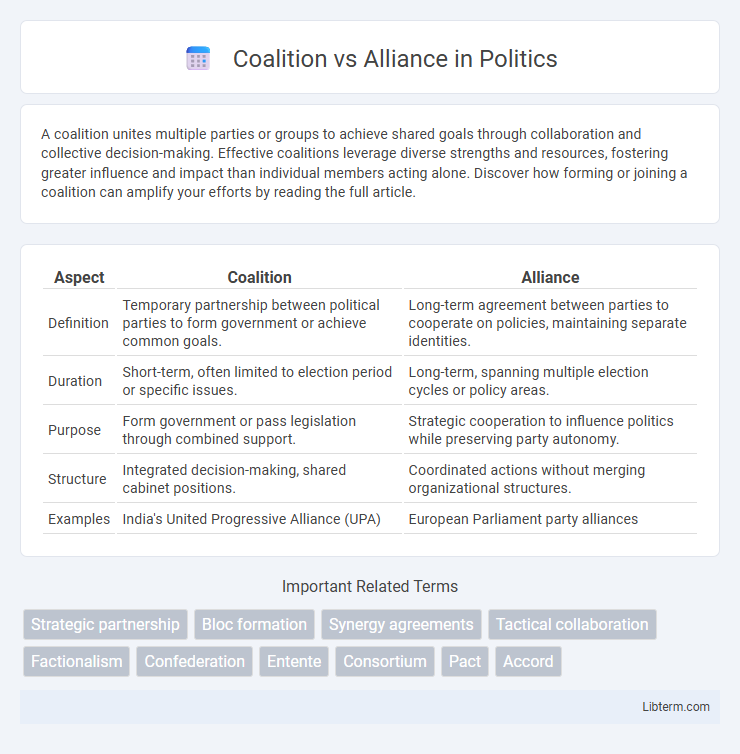A coalition unites multiple parties or groups to achieve shared goals through collaboration and collective decision-making. Effective coalitions leverage diverse strengths and resources, fostering greater influence and impact than individual members acting alone. Discover how forming or joining a coalition can amplify your efforts by reading the full article.
Table of Comparison
| Aspect | Coalition | Alliance |
|---|---|---|
| Definition | Temporary partnership between political parties to form government or achieve common goals. | Long-term agreement between parties to cooperate on policies, maintaining separate identities. |
| Duration | Short-term, often limited to election period or specific issues. | Long-term, spanning multiple election cycles or policy areas. |
| Purpose | Form government or pass legislation through combined support. | Strategic cooperation to influence politics while preserving party autonomy. |
| Structure | Integrated decision-making, shared cabinet positions. | Coordinated actions without merging organizational structures. |
| Examples | India's United Progressive Alliance (UPA) | European Parliament party alliances |
Understanding the Terms: Coalition vs Alliance
A coalition refers to a temporary partnership formed between diverse groups or nations to achieve a specific goal, often in the context of politics or military operations. An alliance implies a more formal and usually long-term agreement between parties, emphasizing mutual support and shared interests beyond a single objective. Understanding these distinctions is crucial for analyzing international relations and strategic collaborations.
Key Definitions and Distinctions
A coalition is a temporary alliance of distinct parties or groups formed to achieve a specific goal, often dissolving once the objective is met. An alliance is a more enduring and formal agreement between entities, such as countries or organizations, established for mutual benefit and strategic cooperation. Key distinctions include the duration, purpose, and level of commitment, with coalitions being short-term and issue-specific, while alliances involve long-term collaboration and shared interests.
Historical Contexts of Coalitions and Alliances
Coalitions and alliances have played pivotal roles in shaping historical geopolitical landscapes, with coalitions often formed for short-term objectives such as wartime efforts, exemplified by the Allied Powers in World War II. Alliances generally involve long-term commitments and mutual defense agreements, as seen in the enduring North Atlantic Treaty Organization (NATO) established in 1949. Understanding these distinctions highlights how coalitions respond to immediate crises, while alliances foster sustained political and military cooperation over time.
Structural Differences Between Coalitions and Alliances
Coalitions are typically temporary arrangements formed around specific goals, with member states maintaining distinct autonomy and flexible commitments, while alliances represent more formal, long-term partnerships with structured institutions and legally binding agreements. Coalitions often lack permanent organizational frameworks and may dissolve after achieving their objectives, whereas alliances usually establish comprehensive command structures and sustained cooperation mechanisms. The structural differences influence decision-making processes, with coalitions favoring consensus-based approaches and alliances adhering to formalized protocols and collective defense commitments.
Purposes and Objectives of Each Formation
A coalition forms around a specific, often short-term objective such as influencing policy or addressing an immediate crisis, bringing together diverse groups focused on a singular goal. An alliance typically represents a long-term, formal partnership between entities like nations or organizations, aimed at mutual support, defense, or sustained cooperation. While coalitions prioritize flexibility and issue-based collaboration, alliances emphasize stability and enduring strategic relationships.
Formation Processes: Coalition vs Alliance
Coalition formation often involves temporary agreements between diverse parties united by a specific goal, typically emerging quickly in response to immediate issues. Alliance formation is usually a formal, long-term partnership based on shared strategic interests, requiring extensive negotiation and mutual commitment. The processes differ in scope and duration, with coalitions emphasizing rapid collaboration and alliances focusing on sustained cooperation.
Notable Examples in Politics and Business
Coalitions such as the European Union exemplify political alliances formed for shared governance and mutual benefit among member states, while alliances like NATO focus on collective security through military cooperation. In business, coalitions appear as strategic partnerships like the Renault-Nissan-Mitsubishi Alliance, enhancing competitive advantage through resource sharing and joint innovation. Both structures facilitate collaboration but differ in scope, with coalitions often broader and issue-specific, and alliances typically geared towards sustained, formal cooperation.
Advantages and Disadvantages Compared
Coalitions offer flexibility by allowing diverse parties to collaborate temporarily for specific goals, enhancing resource pooling and expertise sharing while posing challenges in achieving long-term commitment and coherent strategies. Alliances typically provide stronger unity and stability through formal agreements, fostering trust and consistent cooperation, but may suffer from rigid structures and slower decision-making due to the need for consensus among members. The choice between coalition and alliance depends on the desired balance between adaptability and sustained partnership effectiveness.
Impact on Decision-Making and Power Dynamics
Coalitions often involve temporary partnerships with fluid power dynamics, allowing member entities to influence decision-making based on shifting interests and strategic needs. Alliances tend to be formal, long-term agreements with structured decision-making processes that distribute power more evenly among members to ensure collective stability. The impact on decision-making in coalitions is more flexible but less predictable, while alliances promote consistent, collaborative governance and shared authority.
Choosing Between Coalition or Alliance: What Factors Matter?
Choosing between a coalition and an alliance depends on factors such as the scope of cooperation, duration of the partnership, and organizational goals. Coalitions often involve temporary, issue-specific collaboration among diverse groups, while alliances represent long-term, strategic partnerships with shared objectives. Consider the level of commitment, decision-making processes, and desired outcomes to determine the most effective form of collaboration.
Coalition Infographic

 libterm.com
libterm.com